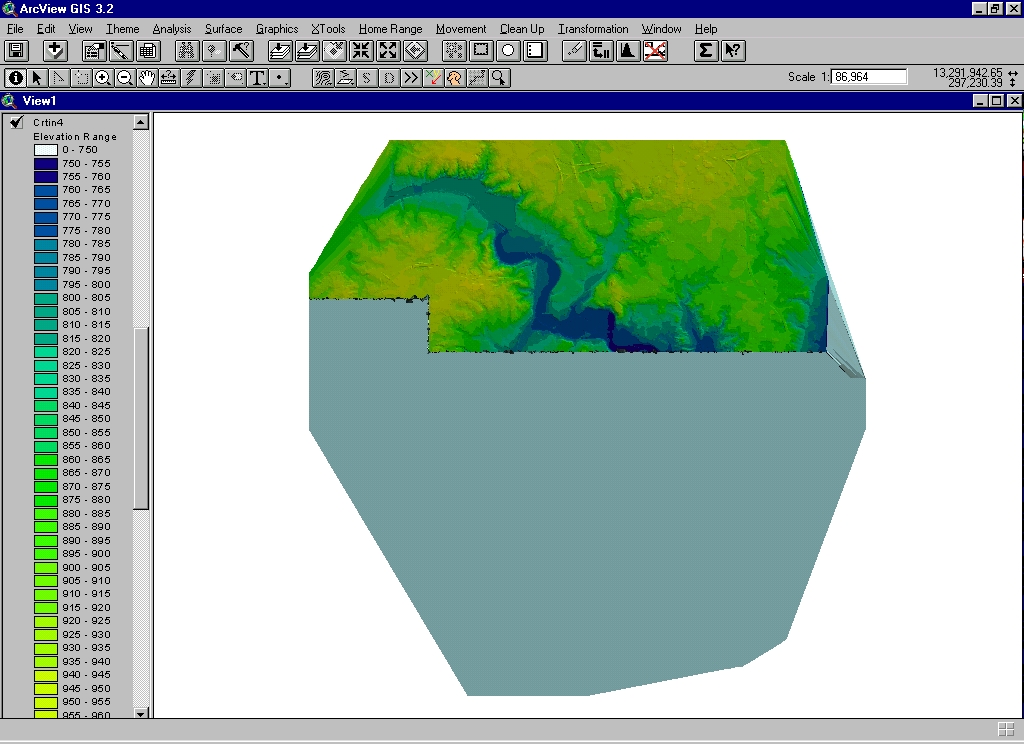BASE MAPS FROM THE CITY.
![]()
BASE MAPS FROM THE CITY.
Parcel map of the City of Ann Arbor (source: City Hall.
Map accuracy standards are known by them.)
![]()
Triangulated Irregular Network (TIN)--entire City at once (as per limitations
of elevation data, above--the gray/blue area has zero elevation according
to the database and was included here only to indicate City boundaries).
A TIN joins nearby digitized points into triangular facets that produce
a 3D appearance. Here, the data is split into 5 foot intervals (to
match the contour interval). Note the outlets of Traver Creek and
of Allen Creek into the Huron River--what is colored blue is between contours.
 |
The map below is a scanned image from the first Venturi, Scott Brown, and Associates document, The University of Michigan Campus Plan, Ann Arbor, Michigan, Phase 1 Overview. We do not have the electronic files. The quotation below is taken from that document.
"This classification scheme, provided by SEMCOG, for urban stream water quality potential is based on imperviousness (Schueler 1994: Tom Schueler, The Importance of Imperviousness, Watershed Protection Techniques, Vol. 1, No. 3, Fall, 1994). Impervious surfaces include roads, parking lots, rooftops, and other impermeable surfaces usually associated with urban landscapes.Legend for the maps below:
Increases in impervious surfaces have negative effects on the hydrologic cycle. The impacts that may ensue include: increased flooding nad stream bank erosion, greatly diminshed water quality, degraded habitat, reduced groundwater recharge and reduced baseflow, and the addition of pollutant loads from stormwater runoff."
When present, the bold red line indicates university boundaries.Base map source: UM Facilities, Planning and Design.
1995 percent impervious cover (characterization of ranges from VSB document--unknown what happens between 10-11 and 25-26):green: Low impervious area (0%-10%). Potentially sensitive streams.
yellow: Moderate impervious area (11%-25%). Potentially impacted streams.
purple: High impervious area (26% or greater). Potentially severely impacted streams.
The scanned image is placed behind the City parcel map. The projections
do not fit exactly but are close. In order to get the VSB map into
a GIS form, one might consider digitizing the VSB map; then, however, the
digitized map would not fit exactly with the City maps. Instead,
I chose to overlay the parcel map on the VSB map and make a decision about
each parcel--whether it fell into the green, yellow, or purple category
of the VSB map. The lines of partition in the VSB map do not correspond
with the City parcel map; presumably, the VSB parcel boundaries are those
of the county land use parcels, or some such; they are not the city parcel
boundaries. Thus it is useful to include the VSB map in any analysis
that might use the parcel map colored by impervious type. The advantage
to having a parcel map colored by impervious type is to be able to make
estimates per area (creekshed, for example) of the amount of yellow land
by parcel within that creekshed. This map is not yet complete.
Randy Deshazo, graduate student, College of Architecture and Urban Planning
is helping with this task.
Steep slope ordinance summary: City
of Highland Park, Illinois.
City of Ann Arbor Home Page